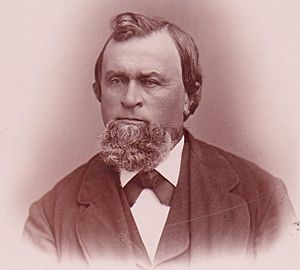Rancho Campo de los Franceses facts for kids

Rancho Campo de los Franceses was a large piece of land in California. It was about 48,747 acres, which is like 76 square miles! The Mexican government gave this land as a grant in 1844. The name "Campo de los Franceses" means "French Camp" in English. It got this name because French-Canadian fur trappers used to camp there in the winter. This land grant included the areas where the towns of French Camp and Stockton are today.
Contents
The Story of Rancho Campo de los Franceses
Early Settlers and Friends
Carlos Maria Weber was born in Germany in 1814. His name was Karl David Weber, but he later changed it to Charles. He came to America in 1836. In 1841, he traveled all the way from Missouri to California.
When he arrived, Carlos worked for a famous man named John Sutter. Carlos then moved to San José in 1842. There, he became business partners with Guillermo Gulnac.
Guillermo Gulnac was born in New York. He was a blacksmith and a fur trapper. He came to San José in 1833. Guillermo became a Mexican citizen. He and Carlos ran many businesses together. They had a corn mill, a bakery, and a blacksmith shop. They also made shoes and soap, and raised cattle.
The Land Grant Begins
Guillermo Gulnac, as a Mexican citizen, asked the governor for a large piece of land. He wanted it for himself and eleven other families. The governor agreed to give the land to Guillermo. He could then arrange for the other families to settle there.
In 1843, Carlos Weber and Guillermo Gulnac ended their business partnership. Guillermo tried to settle the Rancho Campo de los Franceses, but it was difficult. So, in 1845, he sold the land to Carlos Weber.
Carlos Weber and the Mexican-American War
In 1846, Carlos Weber encouraged many people to move to the rancho. But then, the Mexican–American War started. Carlos was seen as both a Mexican and an American. A Mexican general offered him a leadership role, but Carlos said no. Later, he became a captain in the United States cavalry.
This decision made some of his Mexican business partners lose trust in him. So, in 1849, Carlos sold his businesses.
Founding Stockton
Carlos Weber moved to the rancho in 1847. In 1849, he planned out a town and called it Tuleburg. Soon after, he changed the name to Stockton. He named it after Commodore Robert F. Stockton, a naval officer.
Stockton was at the end of the San Joaquin River where boats could travel. This made it a great place for miners to get supplies during the California Gold Rush. The city grew very quickly. Carlos Weber even went to the gold fields himself. He worked as a gold prospector and a merchant.
Family Life and Later Years
In 1850, Carlos returned from the gold mines. He married Helen Murphy. Helen and Carlos moved to a place in Stockton that is still called Weber Point today. They had three children: Charles, Julia, and Thomas. Carlos's brother, Adolf, also came from Germany. He became a chemist and started a bank.
After the Mexican-American War, California became part of the United States. The 1848 Treaty of Guadalupe Hidalgo said that old land grants would still be valid. So, Carlos Weber filed a claim for his land in 1852. The government confirmed his ownership in 1861.
Important Places to See
- First Building in Stockton: In August 1844, Thomas Lindsay built the very first home on this land.
- French Camp: This was a popular meeting spot for French-Canadian fur trappers. They camped here with their families from about 1832 to 1845.
- Weber Point: This is where Carlos M. Weber built his home in 1850. It was a two-story house made of adobe and redwood. Captain Weber lived there until he passed away in 1881.

